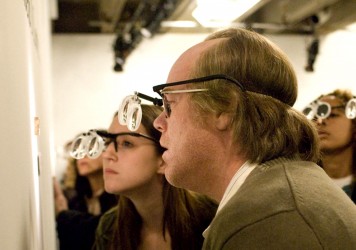
“You mess with Spidey, you mess with New York!” More than any other superhero, Spider-Man is New York. He’s the kid from Queens, the blue-collar nerd who got bitten by a radioactive spider and became the world’s most famous teenage crime fighter. In Sam Raimi’s 2002 film, a random man in the crowd hollers the above line as a group of New Yorkers protect Spider-Man (Tobey Maguire) from his arch nemesis The Green Goblin (Willem Dafoe). It’s a sincere moment, unburdened by the self-reflective seriousness found in the genre’s contemporary efforts.
Ironically for a film often cited as kickstarting the modern superhero movie trend, Raimi’s Spider-Man is a bland superhero movie by today’s standards. It lacks a world-ruling plot, a big CGI finale and it doesn’t trade off 9/11 imagery. It is simply a story about a guy, the girl he loves and the city he shields from harm. It wasn’t Raimi’s intention to make a cinematic dissertation on the different types of heroism. Nor for that matter was he attempting to make a generic superhero movie. He set out to make a Spider-Man movie, and making a great Spider-Man movie requires making a great New York movie.
As such, Raimi’s version of New York is a place where fantasy and reality meet. There is no doubt that Spider-Man is a fantasy, as Peter reacts to his overnight transformation with a goofy grin because he’s developed shredded abs. He and the rest of New York don’t freak out at the idea of a guy swinging between buildings. In this city and the world Raimi creates within it, that seems perfectly normal. The director injects realism into the story by having his characters work mundane jobs to meet mundane ends like paying rent. They lead regular lives, and we are given hints of their everyday activities. In this film, New York is more than a setting, as Raimi gives his supporting characters lives outside of Spider-Man and The Green Goblin’s ideological conflict.

Peter Parker’s love interest, Mary Jane (Kirsten Dunst), isn’t concerned with the guy flying around her head in spandex because she has her own problems. She works as a waitress, struggles at auditions (“They said I needed acting lessons; a soap opera said I needed acting lessons”) and has a boyfriend who is more concerned with maintaining his social status than her. She is shown getting on with her life, which Spider-Man keeps interrupting. MJ might be the perennial damsel in distress and she might not exist outside her relationship with Peter, but Raimi lets her live her own life.
Harry Osborn (James Franco), as best friend of the hero and son of the villain, is the character with the closest ties to the film’s central conflict – but even he is more concerned with getting a girlfriend and impressing his father. Harry is always defined by his wealth (“His father will fire your father”) and spends the film trying to prove he is worth more than what he inherits. Like so many of the supporting characters, he is only forced into the overarching plot when the story requires it.
Not wanting to create a stylised New York, Raimi even sours the sugary fantasy that says this is a place where all your dreams come true. In one of the most important scenes in his entire Spider-Man trilogy, MJ starts paying attention to the always earnest Peter as they set out their hopes and aspirations. It would have been easy for MJ to become a famous actress and for Peter to work his way through college, but that isn’t Spider-Man – he’s the hero who can’t catch a break, and Raimi takes great pleasure in making both MJ and Peter hustle to make a living. They are relatable because they deal with real problems.
Raimi’s attention to the supporting characters, to how they interact with Peter, results in an authentic depiction of New York which Spider-Man and his superhuman abilities occasionally puncture. There’s a brief pause, then life continues. By the time we see Spider-Man swinging between New York’s iconic skyscrapers at the end of the film, Raimi has succeeded in bringing the city and the people who live in it to life. This world of taxi drivers, stockbrokers and ordinary working folk is integral to Spider-Man, and we want him to save it.
Published 5 Jul 2017

By Nick Funnell
The actor is at his honest, emotive best in Marc Webb’s 2012 reboot.

By Eli Zeger
The writer/director’s hyperreal 2008 debut remains a transformative study of life, love and loneliness.

Tom Holland gets top marks as Marvel’s teenage web-slinger goes back to school.